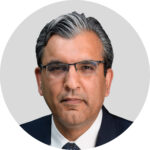Back in early-November, we asked industry commentators to share their views about what they think will unfold in markets in the coming weeks:
‘EM bonds could provide meaningful tailwind’
Shaniel Ramjee, senior investment manager, multi asset, Pictet
 We believe emerging market bonds will prove lucrative for investors in 2023. Emerging market central banks have adopted a more orthodox monetary policy stance this cycle, increasing interest rates by more than had been expected and in many cases emerging economies have reached their inflation peak. The yields on offer are attractive and, if the US dollar stabilises, this could provide a meaningful tailwind. We are also bullish on inflation-linked US and UK bonds for next year. The positive real yields and varying risk profiles will prove attractive to investors – especially in an environment where rates are uncertain.
We believe emerging market bonds will prove lucrative for investors in 2023. Emerging market central banks have adopted a more orthodox monetary policy stance this cycle, increasing interest rates by more than had been expected and in many cases emerging economies have reached their inflation peak. The yields on offer are attractive and, if the US dollar stabilises, this could provide a meaningful tailwind. We are also bullish on inflation-linked US and UK bonds for next year. The positive real yields and varying risk profiles will prove attractive to investors – especially in an environment where rates are uncertain.
‘Japanese stocks should attract inflows’
Paul ffolkes Davis, chairman, Rising Sun Management, investment adviser to NAVF
 We expect Japanese activist investing to continue to grow in 2023. There are several reasons why. Many companies are under-researched, offer below average price/earnings (P/E) ratios and show high – and rising – balance sheet cash reserves. Corporate governance reform – part of the Abenomics policy push being continued by Japanese prime minister Fumio Kishida – is also helping activists pursue company reorganisations to boost share prices. For UK and international investors, Japanese stocks (on a low P/E ratio with a weak yen) should attract inflows, especially given high US stock P/E multiples and the strong US dollar, which just serves to emphasise that they constitute the cheapest developed market in the world.
We expect Japanese activist investing to continue to grow in 2023. There are several reasons why. Many companies are under-researched, offer below average price/earnings (P/E) ratios and show high – and rising – balance sheet cash reserves. Corporate governance reform – part of the Abenomics policy push being continued by Japanese prime minister Fumio Kishida – is also helping activists pursue company reorganisations to boost share prices. For UK and international investors, Japanese stocks (on a low P/E ratio with a weak yen) should attract inflows, especially given high US stock P/E multiples and the strong US dollar, which just serves to emphasise that they constitute the cheapest developed market in the world.
‘Recovery depends on ending war in Ukraine’
Brian Jacobsen, senior investment strategist for the Systematic Edge Multi-Asset team, Allspring Global Investments
 The most important thing to know is the timing, duration and depth of a recession. Markets typically bottom and then start a recovery a few months before the economic numbers improve. The duration and depth of the recession in Europe depends on energy supplies. We could get some reprieve in spring, but relief and recovery depend on stopping Russia’s war against Ukraine. For the US, the Federal Reserve was late to start hiking and they will likely be late to stop, with a recession in the first part of the year being the price that is paid. A solid market recovery can start in spring when it becomes clear that the Fed will have to start cutting rates again.
The most important thing to know is the timing, duration and depth of a recession. Markets typically bottom and then start a recovery a few months before the economic numbers improve. The duration and depth of the recession in Europe depends on energy supplies. We could get some reprieve in spring, but relief and recovery depend on stopping Russia’s war against Ukraine. For the US, the Federal Reserve was late to start hiking and they will likely be late to stop, with a recession in the first part of the year being the price that is paid. A solid market recovery can start in spring when it becomes clear that the Fed will have to start cutting rates again.
‘Fed continues on tightening path’
Salman Ahmed, global head of macro strategic asset allocation, Fidelity International
 Hopes the Fed would soon pivot away from its tightening path have been quashed. The central bank appears fully committed to getting inflation under control. Nevertheless, economic data in the US is proving relatively resilient, as the dollar continues to strengthen. We have pushed out our expectations for a hard landing in the US to mid-2023. Recession in Europe, meanwhile, appears more imminent. The region faces a severe energy crisis that could lead to a 4-5% hit to euro area GDP. High prices and threat of gas shortages are sapping consumer spending and hobbling industry. The ECB has hiked rates by 0.75% but the window for further tightening is closing quickly given the deteriorating outlook.
Hopes the Fed would soon pivot away from its tightening path have been quashed. The central bank appears fully committed to getting inflation under control. Nevertheless, economic data in the US is proving relatively resilient, as the dollar continues to strengthen. We have pushed out our expectations for a hard landing in the US to mid-2023. Recession in Europe, meanwhile, appears more imminent. The region faces a severe energy crisis that could lead to a 4-5% hit to euro area GDP. High prices and threat of gas shortages are sapping consumer spending and hobbling industry. The ECB has hiked rates by 0.75% but the window for further tightening is closing quickly given the deteriorating outlook.
‘Emergence of investment opportunities in hydrogen’
Scott Levy, CEO, Orestes
 We expect to see a widening spread between conventional debt issuance and authenticated green bonds. In addition, hydrogen investment opportunities should emerge on a wider scale as this becomes the focus of EU policy to secure energy freedom. All of this will provide emerging opportunities for investors to get access to this exciting asset class. Battery and hydrogen are cornerstone themes of this developing market.
We expect to see a widening spread between conventional debt issuance and authenticated green bonds. In addition, hydrogen investment opportunities should emerge on a wider scale as this becomes the focus of EU policy to secure energy freedom. All of this will provide emerging opportunities for investors to get access to this exciting asset class. Battery and hydrogen are cornerstone themes of this developing market.
‘Managers of private businesses will benefit’
Helen Steers, partner and lead manager, Pantheon International
 We expect private equity to continue to grow in popularity, driven by demand from companies that are staying private for longer, and often choosing not to list at all. The number of US and European private equity-backed companies has increased dramatically over the past 10 years, while there are now fewer public companies globally than in 2011. Management teams of private businesses benefit, not just from the capital injection but also from private equity managers’ hands-on approach to increasing the value of their firms, and the opportunity to implement long-term growth plans away from the public spotlight.
We expect private equity to continue to grow in popularity, driven by demand from companies that are staying private for longer, and often choosing not to list at all. The number of US and European private equity-backed companies has increased dramatically over the past 10 years, while there are now fewer public companies globally than in 2011. Management teams of private businesses benefit, not just from the capital injection but also from private equity managers’ hands-on approach to increasing the value of their firms, and the opportunity to implement long-term growth plans away from the public spotlight.
‘Stockpicking more important than style’
Jamie Ross, portfolio manager, Janus Henderson
 Since the start of the Covid pandemic, European growth stocks have performed similarly to value stocks. However, this encompasses two distinct periods, the pre-vaccine period where growth outperformed value by 21.6% and post-vaccine, where value outperformed growth by 23.8%. Many factors explain this divergence, deflationary versus reflationary pressures and ‘stay-at-home’ versus ‘reopening’ among the most meaningful. Looking into 2023, the situation is more balanced. There is evidence of inflationary pressures abating – supply chain issues ameliorating, the oil price declining, economic activity easing – which would typically favour growth stocks. But countering this, the valuation of growth stocks remains elevated versus value. Next year, stockpicking could matter far more than exposure to a particular investment style.
Since the start of the Covid pandemic, European growth stocks have performed similarly to value stocks. However, this encompasses two distinct periods, the pre-vaccine period where growth outperformed value by 21.6% and post-vaccine, where value outperformed growth by 23.8%. Many factors explain this divergence, deflationary versus reflationary pressures and ‘stay-at-home’ versus ‘reopening’ among the most meaningful. Looking into 2023, the situation is more balanced. There is evidence of inflationary pressures abating – supply chain issues ameliorating, the oil price declining, economic activity easing – which would typically favour growth stocks. But countering this, the valuation of growth stocks remains elevated versus value. Next year, stockpicking could matter far more than exposure to a particular investment style.
‘Shift to a higher-yielding corporate bond market’
Rhys Davies, manager, Invesco Monthly Income Plus Fund
 We are experiencing a structural shift to a higher-yielding corporate bond market. Central banks are committed to fighting inflation and are finally allowing the market to reprice to higher yields. Many high-yield bond issuers took advantage of easy borrowing conditions in 2021. Companies that wish to refinance their debt in this new environment will pay significantly higher coupons. However, the bonds of any company that can afford those higher borrowing costs will represent a fantastic opportunity for income investors. Leveraged companies that survived due to low interest rates will struggle. I think defaults will rise and a higher rate will persist, re-enforcing demand from creditors for higher coupons and a better deal.
We are experiencing a structural shift to a higher-yielding corporate bond market. Central banks are committed to fighting inflation and are finally allowing the market to reprice to higher yields. Many high-yield bond issuers took advantage of easy borrowing conditions in 2021. Companies that wish to refinance their debt in this new environment will pay significantly higher coupons. However, the bonds of any company that can afford those higher borrowing costs will represent a fantastic opportunity for income investors. Leveraged companies that survived due to low interest rates will struggle. I think defaults will rise and a higher rate will persist, re-enforcing demand from creditors for higher coupons and a better deal.
‘Valuations reach levels that warrant a closer look’
Thomas Samson, portfolio manager, Muzinich & Co
 A combination of inflationary pressures and a change in central bank monetary policy have resulted in fixed-income markets experiencing one of the largest corrections on record. Yet while increased levels of investor anxiety have been reflected in a broad market sell-off, valuations have reached levels that warrant a closer look. Nevertheless, risks remain. As such, we would advocate increasing exposure to higher-quality credits with strong balance sheets, while reducing exposure to smaller, less well-known issuers. This should help insulate investors against what we expect to be periods of ongoing volatility.
A combination of inflationary pressures and a change in central bank monetary policy have resulted in fixed-income markets experiencing one of the largest corrections on record. Yet while increased levels of investor anxiety have been reflected in a broad market sell-off, valuations have reached levels that warrant a closer look. Nevertheless, risks remain. As such, we would advocate increasing exposure to higher-quality credits with strong balance sheets, while reducing exposure to smaller, less well-known issuers. This should help insulate investors against what we expect to be periods of ongoing volatility.
‘No reprise for growth’
Richard de Lisle, manager, VT De Lisle America Fund
 The wonderful thing about bear markets is their predictive power. Therefore, I predict the S&P 400 (mid-cap) value component will outperform other index groups and the Nasdaq 100 will underperform. If we move on to groups, energy will outperform, followed by industrials. The ETFs most commonly used for these groups are the XLE and the XLI. In third place, regional banks will also beat the S&P 500. In a nutshell, the relative strength and weakness has been established, even if we don’t adjust for beta, and it’s value going forward with no reprise for growth. As the recession bites, smaller start to do better which is why we eschew the S&P 500 value and go with the 400.
The wonderful thing about bear markets is their predictive power. Therefore, I predict the S&P 400 (mid-cap) value component will outperform other index groups and the Nasdaq 100 will underperform. If we move on to groups, energy will outperform, followed by industrials. The ETFs most commonly used for these groups are the XLE and the XLI. In third place, regional banks will also beat the S&P 500. In a nutshell, the relative strength and weakness has been established, even if we don’t adjust for beta, and it’s value going forward with no reprise for growth. As the recession bites, smaller start to do better which is why we eschew the S&P 500 value and go with the 400.
‘Innovation drives value’
Mikhail Zverev, fund manager, TB Amati Strategic Innovation Fund
 Innovation will continue to create value for the companies that drive, enable or adopt it – and for their shareholders. These changes are often technologically inevitable, as well as economically resilient in the long run. Today, some of these companies look vulnerable to a short-term economic cycle, making valuations more attractive. Investors will soon begin to look through the recession and inflation risk into the structural changes ahead. However, this recovery will be different from the previous boom. Innovation benefits will accrue more to companies that have profitability, cash generation and balance sheet strength that allows them to self-fund their growth during uncertain economic times. This, along with investors’ increased valuation discipline, will define the performance of global growth companies in the coming years.
Innovation will continue to create value for the companies that drive, enable or adopt it – and for their shareholders. These changes are often technologically inevitable, as well as economically resilient in the long run. Today, some of these companies look vulnerable to a short-term economic cycle, making valuations more attractive. Investors will soon begin to look through the recession and inflation risk into the structural changes ahead. However, this recovery will be different from the previous boom. Innovation benefits will accrue more to companies that have profitability, cash generation and balance sheet strength that allows them to self-fund their growth during uncertain economic times. This, along with investors’ increased valuation discipline, will define the performance of global growth companies in the coming years.
‘US dollar continues to dominate global markets’
Harriet Ballard, multi-asset and macro strategist, Aviva Investors
 US dollar appreciation has dominated performance across major currencies throughout 2022, affecting financial stability and inflation globally. This looks set to continue, as the drivers of this year’s trend remain in place. Slowing global growth has long been associated with dollar strength as investors seek safer assets, so downside surprises to the global outlook could yet generate additional USD demand. If slowing growth has pushed cautious investors into dollars, then rising rates have been the major pull factor for return-seekers. The Federal Reserve has been the central bank leading the move to higher rates, increasing the attractiveness of USD holdings. Until an easing from the Fed is on the horizon, we should expect this to continue.
US dollar appreciation has dominated performance across major currencies throughout 2022, affecting financial stability and inflation globally. This looks set to continue, as the drivers of this year’s trend remain in place. Slowing global growth has long been associated with dollar strength as investors seek safer assets, so downside surprises to the global outlook could yet generate additional USD demand. If slowing growth has pushed cautious investors into dollars, then rising rates have been the major pull factor for return-seekers. The Federal Reserve has been the central bank leading the move to higher rates, increasing the attractiveness of USD holdings. Until an easing from the Fed is on the horizon, we should expect this to continue.
‘Management will be key to generating growth’
Martin Conroy, portfolio manager, circular economy strategy, KBI Global Investors
 The companies most likely to produce earnings growth in 2023 are those with a track record of growth throughout the economic cycle, or those exposed to end markets that continue to benefit from recent fiscal policy initiatives, e.g. renewable energy, water and infrastructure end markets. As we move past peak inflation, management teams are facing an environment where lower pricing, and in some cases declining volumes, will make it difficult to maintain margins. The control of variable costs will be critical. At the market level, earnings growth looks set to be subdued at best, creating a set-up where execution by management teams will be key to generating growth.
The companies most likely to produce earnings growth in 2023 are those with a track record of growth throughout the economic cycle, or those exposed to end markets that continue to benefit from recent fiscal policy initiatives, e.g. renewable energy, water and infrastructure end markets. As we move past peak inflation, management teams are facing an environment where lower pricing, and in some cases declining volumes, will make it difficult to maintain margins. The control of variable costs will be critical. At the market level, earnings growth looks set to be subdued at best, creating a set-up where execution by management teams will be key to generating growth.
‘We expect UK corporate M&A activity to increase’
Richard Scrope, manager, VT Tyndall Global Select Fund
 Multinational companies and private equity will almost certainly be running their slide rulers over UK companies at the moment. Not only is sterling at generational lows against most currencies but the valuations are also trading at a significant discount to most of their international peers as investors have shunned the island. This is especially true for UK mid caps. The are no shortage of world-class companies within these shores, and management teams remain upbeat despite the macroeconomic and governmental uncertainties. We expect mergers and acquisitions of UK corporates to increase over the coming months as the company valuations are now too low to ignore, and particularly for cash-rich entities with US dollar earnings.
Multinational companies and private equity will almost certainly be running their slide rulers over UK companies at the moment. Not only is sterling at generational lows against most currencies but the valuations are also trading at a significant discount to most of their international peers as investors have shunned the island. This is especially true for UK mid caps. The are no shortage of world-class companies within these shores, and management teams remain upbeat despite the macroeconomic and governmental uncertainties. We expect mergers and acquisitions of UK corporates to increase over the coming months as the company valuations are now too low to ignore, and particularly for cash-rich entities with US dollar earnings.
This article first appeared in the November edition of Portfolio Adviser Magazine







